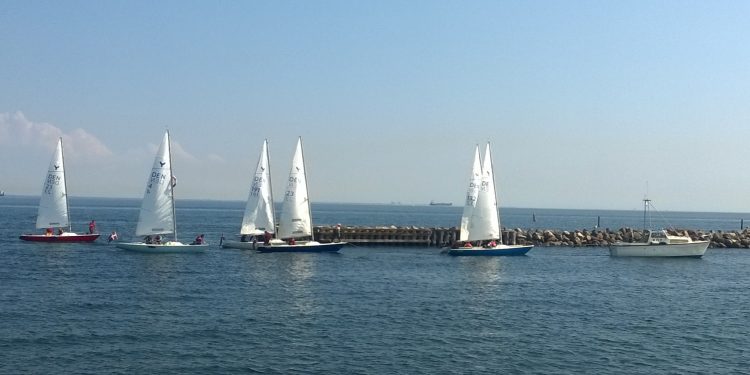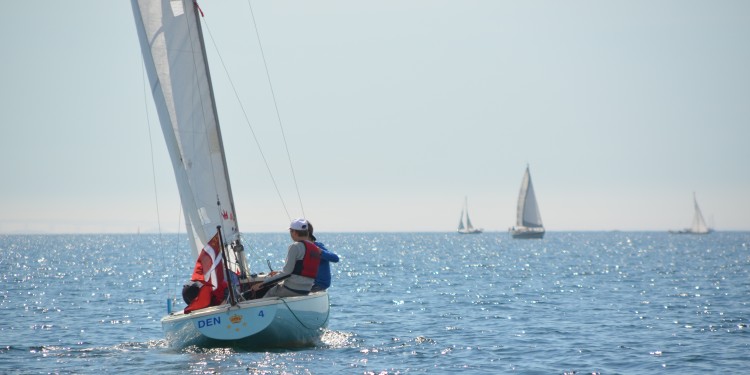Season coming up – take up SAILING while in Denmark
In a country with 7,314 km of coastline and 406 islands, sailing is the obvious choice for a hobby, even for the most committed of landlubbers. And in Denmark, sailing is for all ages and all wallet sizes.
The article continues below.
By Inger Stokkink Pictures: Bente D. Knudsen/ Alexander Gjedsted
Sailing in Denmark gives you a different perspective of the land and its people, literally, as you gaze at the coast from the deck of a boat, but also figuratively, as you see first-hand how the Danish way of living is influenced by life at sea, both throughout its history and still today.
And sailing is a hobby that can easily be slotted into your daily life, with shorter working days providing the chance to make quick trips in the evening after work, or longer day-trips during the weekend.
You can even, like some Danes do, sail out after work and spend the night anchored in a quiet spot, before heading back to the harbour early in the morning to go straight to work!
Instead of being an elite sport, sailing is a kind of folk sport in Denmark, especially in comparison to countries like Germany and the UK.
The article continues below.
“The sea is always close by in Denmark. But the low cost of sailing also plays an important role,” says Steen Wintlev – Jensen from Dansk Sejlunion (DS), the association of all sailing clubs in Denmark, when asked about the appeal of the wide open sea.
“Membership of a sailing club is on average DKK 1,000 per year, with an extra fee if you are taking sailing lessons. It’s also relatively cheap to keep a boat yourself.”
The article continues below.
Find your nearest club – they nearly all have sailing schools
If you want to learn how to sail, the sailing school of the nearest sailing club is the best place to start.
You should be able to find one easily as most of the local Danish harbours have their own. You can also check the Dansk Sejlunion website which lists accredited sailing schools. Find it here.
Be aware that the language can be a stumbling block though. Be aware that the language can be a stumbling block. In most cases Danish will be the language used in the sailing school.
In general you need to speak a little bit of Danish to get started and sailing is also an excellent opportunity to submerge yourself actively in the language, which, as we all know, is the best way to learn it.
This means that you at least need to speak a little bit of Danish to get started. But it also means that you have an excellent opportunity to submerge yourself actively in the language, which, as we all know, is the best way to learn it.
Life at sea can be a great equaliser too as sailing has its own jargon that all beginners, Danes or other, will have to learn from scratch. That is when you’ll find out that Danes can have language problems too.
The article continues below.
Don’t let the language barrier hold you back
If you are not going to be in Denmark for a long time, or if you have decided that learning Danish is just not an option, then there are some sailing schools that have English-spoken courses.
KDY (Kongelig Dansk Yacht Klub) sailing school based at Skovshoved harbour just to the north of Copenhagen has an international section which instructs sailing in English on Wednesday and Thursday evenings.
KDY cooperates with Sailing First which offers RYA accredited sailing courses, for those who want to get globally recognised sailing qualifications that they can use after they have left Denmark.
Both KDY and Skovshoved Sailing club also have sailing courses in English for children.
Hellerup Sailing club provides access to its club boats for expats, with many from the United Nations involved in the club.
In Jutland, Marselisborg Sejlklub in Aarhus has a open approach to teaching expats in Denmark. Linda Huibers started sailing there two years ago.
”I had been sailing before, but didn’t think I was good enough to sail on my own,”she says. “I sailed with two Danes and a German, so lessons were sometimes in Danish, sometimes in English. I didn’t have huge problems with the language, but the German in my boat tended to mix things up. Once he announced a tack, while he actually made a gybe, which can be a tricky procedure. So after that I always double-checked, to find out what he actually meant!”
And don’t be concerned that those running the classes would rather be doing it in Danish.
Åge Thorborg is the leader of Marselisborg Sejlklub’s sailing school, and he thinks English sailing classes give an extra dimension to the club. ”
We started in 2011 with some employees from Vestas, who asked us whether they could take lessons in English. Now we have two English-spoken teams. And even though we have to order instruction books from England, and it sometimes is a bit of a challenge for the Danish instructors, I would recommend having English sailing classes in your club.”
Karen Vanderborcht comes from Belgium and is a member of Aarhus Sejlklub. She did it the hard way: learning to sail and learning Danish at the same time.
”Besides taking lessons in the sailing school, I crewed in regattas (sailing races) during weekends. That way I learned a lot. I became a sailing instructor, I was responsible for the upkeep of one of the school boats, and participated in regattas on a regular basis. I ended up sailing three evenings a week, and very often during weekends as well. I might as well have given up my appartment then, since I was hardly there!”
Nowadays, Karen sails regattas, substitutes as an instructor and is webmaster of Aarhus Sejlklub’s website. Her advice to those keen to set sail:
” Check well in advance whether the sailing school has a waiting list, like Aarhus Sejlklub has. Otherwise, throw yourself at it! Be aware, though, that you have to take the initiative. It’s tiring, but it’s the only way to make things happen. For many sailing schools, it is best to get your membership in place and get registered for courses in the winter.”
The article continues below.
How to get started?
How to get started?
When you are a beginner
If you have difficulties finding a sailing school in your vicinity, call Dansk Sejlunion for help:8820 7000. They don’t have an English website, but they are very helpful on the phone!
Be persistent. It can be overwhelming and lonely when you’re still learning Danish but try to see it as an investment in your future social life.
Ask Danes to repeat themselves if you don’t understand them. At sea, it can be dangerous to be polite, so exclude ambiguity. Don’t worry about sounding over-cautious , it’s far better to err on the side of caution at sea.
When you have sailed before
Sailors will always find their way to a harbour of their liking. Contact Dansk Sejlunion (see above), if you need help with that. And skippers are in more or less permanent need of crew members for sailing (club) races, so you won’t have trouble finding a boat with people to go racing with.
There are also crew finder groups on Facebook for longer passages, Copenhagen Sailing on Meetup (https://www.meetup.com/Copenhagen-Sailing-Meetup/) can be a great place to find contacts.
Qualifications from overseas are often recognized and can be converted to the Danish certificate of competency. This is a must-have if you want to borrow sailing boats such as through Boatflex, the Danish version of Airbnb for boats.
TIP
The article continues below.
What do I need?
What do I need?
A lifejacket
Safety comes first, especially on the water. Danish law requires skippers to have as many lifejackets on board as there are passengers and most sailing schools require students to wear life jackets during lessons.
Sejlsikkert is an initiative from the Tryg Foundation. They provide a safety app and make presentations about safety, including very useful presentations on life jackets.
Many sailing schools have life-jackets on loan for beginners, but it makes sense to buy your own. That way you can be sure you have the right fit, so it won’t bother you when sailing.
Also, if you go sailing on another boat, there won’t always be a lifejacket for you, ( despite the Danish law). Funnily enough, the law doesn’t state that passengers have to wear them!
Your sailing school will require you to wear a life jacket during lessons though.
Safety comes first, especially on the water.
Off-shore sailing pants and jacket
It’s surprising how cold it can be on the water even when the weather feels hot on land.
A woollen sweater, under-layers or a fleece, and rain-proof jackets and pants will keep you comfortable in cold, wet and windy weather. They will also keep you dry from spray coming over the stern.
In the long run, proper sailing clothes are more comfortable.
Sailing boots or shoes
Most of the time, running shoes that are non-slip and leave no black marks will do the trick. And in cold and wet weather you’ll be thankful for rubber boots with warm socks.
Sailing gloves
Are padded gloves without fingertips. They give grip and they protect your hands from burns from slipping lines.
Many sailors use cheap working or gardening gloves from DIY stores as an alternative.
Waterproof smartphone protection
If you use your smartphone a lot, buy a waterproof cover. It’s amazing how quickly a phone gets wet and beyond repair because of saltwater!
The article continues below.
Useful contacts
Useful contacts
Dansk Sejlunion (The Danish Sailing Federation)
Telephone: 8820 7000
www.sejlsport.dk
Kongelige Dansk Yachtklub/KDY (Royal Danish Yacht Club)
Tuborg Havnepark 15
2900 Hellerup
Telephone: 33 14 87 87
Mail: kdy@kdy.dk
www.kdy.dk
Skovshoved Sailing Club
Skovshoved Havn 7
2920 Charlottenlund
Mail: mail@skovshovedsejlklub.dk
or Mail: sejlerskole@skovshovedsejlklub.dk
Hellerup Sailing Club
Paul Elvstrøms Plads 1
DK-2900 Hellerup
kontor@hellerupsejlklub.dk
Marselisborg Sejlklub
Marselisborg Havnevej 100b
8000 Århus C
Åge Thorborg ( contact person sailing school)
Telephone: 40 38 57 16
Mail: sejlerskolen@marselisborgsejlklub.dk
www.marselisborgsejlklub.dk
Aarhus Sejlklub
Kystpromenaden 7
8000 Aarhus C
Telephone: 86 19 06 94
Mail:mail@aarhussejlklub.dk
www.aarhussejlklub.dk
Egå Sejlklub
Egå Havnevej 27
8250 Egå
www.egaasejlklub.dk
Boatflex
Artillerivej 86
2300 Copenhagen
Denmark
www.boatflex.com
Sailing First
RYA Recognized Training Centre
Hellerupvej 24
2900 Hellerup
www.sailingfirst.dk
Support our magazine with a contribution of any size
We do not want to put up a pay-wall, so we need your support and if you find our content relevant and worthwhile, we would value any contribution, however big or small, as a token of your appreciation of our efforts.
How to support:
Transfer any contribution to our bank account at: Your Danish Life/ Danish Expat Media Aps
Danske Bank Account number: 3409 11405673
IBAN: DK68 3000 0011 4056 73
Message: Support







